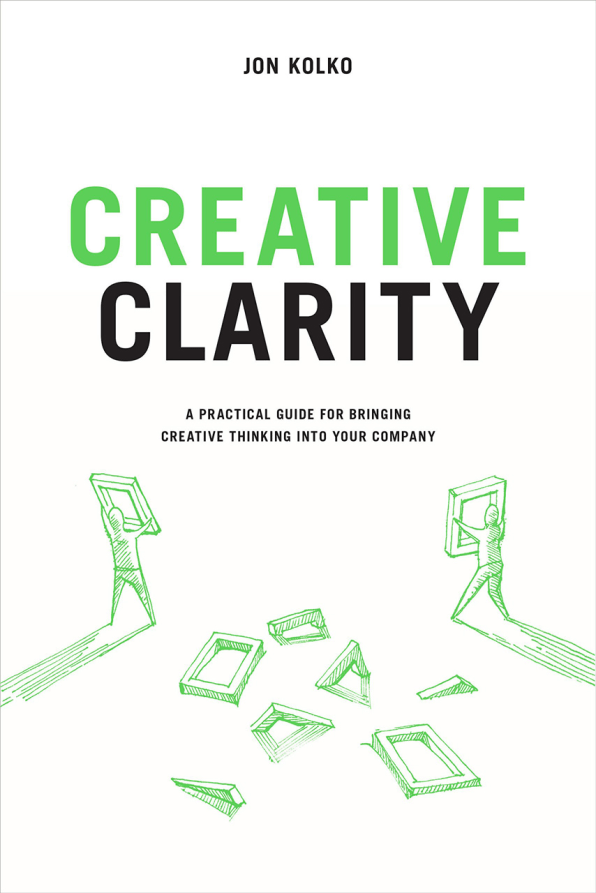Think small.
When I first joined Frog design, a global innovation firm, my role was as an individual creative contributor. I was responsible for making things that helped clients better understand the business problems they faced, and offering creative solutions to those problems. My second project at Frog was for a big telecom client. The small team I was on had been camped out in a conference room for several weeks working on an important deliverable. The work was good, and as we got closer and closer to the deadline, our team felt better and better about what we were delivering—not that we were the ones delivering it.
In a consultancy like Frog, senior roles usually take on more client-facing tasks. Designers may do the work, but a creative director will present and explain that work to the client. Often, that creative director won’t be aware of all of the detailed design decisions that happen along the way. So there’s an awkward handoff when the director takes the work, gets on a plane, and everyone waits nervously for the report about how the meeting went.
We finished that telecom project on a Thursday, around 8 p.m. We had a solid design, a solid story around the design, and we had spent several hours helping Patrick, our creative director, to understand how to best present the materials. We wished him good luck, and he flew to San Jose, California, for the meeting.
The next afternoon, Patrick called to say that the meeting had gone well, the client was happy, and we were likely to get some follow-on work. He said he was really proud of the work, then mentioned in an offhand way that he made some changes that seemed to help the story.

When Patrick showed us the final presentation and design work, it looked nothing like what we had made. He had scrapped 75% of the story we were telling. Our work was still there, but the frame of the work had changed. The hours we had spent arguing over details and agonizing over decisions went down the drain, and we were devastated. I was extremely upset because I felt personally slighted. Red hot, I unloaded on him.He listened, and when I was done, he calmly explained that he really, really liked our work. In his view, it was tactically great (it was executed well, had wonderful craft, and looked beautiful). But based on his experience with the client, he knew it wouldn’t go over well because it didn’t tell the right story. He walked me through changes, explaining why he made them.
I still left mad, vowing to never redo someone’s work—to never sit on a plane and blow away weeks and weeks of creativity. And yet, years later, in the role of design leader, I found myself doing just that. I saw that the work my team had produced wasn’t ready for presentation. My experience told me that it wouldn’t resonate because the narrative wasn’t clear. And the only thing I could do was redo it, quickly, before the meeting. I knew how the designer would feel, and I knew the kind of credibility I would lose. I also knew it was on me because I should have intervened weeks before.
By changing our work, Patrick undermined the team’s efforts. By doing so without telling us, he lost our trust. But had he not changed the work, we probably would have lost the account. And I repeated all of those actions when I was in a position to think both strategically and tactically.
While there are important morals in this story about trust and rework, one of the most important takeaways lies in the difference between working tactically (making things) and working strategically (telling a story). Where Patrick and I redid the team’s work, it was because the artifacts didn’t speak for themselves: They needed a persuasive backstory. We identified the need for the backstory only when the work was done, and consequently, we redid the strategic context of the work only after the completion of tactical work.
If I had been embedded with the team the entire length of the project, I would have had as much ownership to the creative output as they did, and the strategic framing would have become apparent earlier. I could have led the team toward the correct frame, or they would have found their way there on their own.
Mark Rolston, former chief creative officer at Frog, has insight into this type of dual thinking: strategic storytelling and tactical artifact creation. He describes the difference between creative-directing a small group—as at his new firm Argo—and the giant creative team of more than 300 creative professionals that he managed at Frog design.
As a creative leader in a small team, Rolston explains, you are, and should be, directly involved in the creative process. But when you have such a hands-on role, he says, creative direction can run the risk of being too prescriptive. A creative staff literally translates what you say and do, and it’s tempting to fall into a trap of do-as-I-say. The staff is “simply saying ‘now what?’ And you find yourself saying, ‘make that smaller. Smaller.’ You might as well pick up the mouse and do it yourself.”
However, Rolston, adds, a small team affords the ability for more regular check-ins, so critique becomes both serendipitous (it could happen at any time) and regular (it happens all the time). With a small group, it’s easier to maintain a flat organization, which builds trust and empowers people to take more ownership and control. “People know each other and can self-organize.” That self-organization means more opportunities for connection between people and between work.
Critique in such a small team becomes more frequent, as it’s a simple act of walking around the room and seeing what people are doing. “I realized over 30 years of doing this that by showing up at someone’s desk, and saying ‘show me what you got’—you create a sense that I could be there any time, and your work product should maintain velocity and your thinking should maintain enough fidelity that you can talk about the work.” For Rolston, impromptu critiques mean that everyone is always ready. They’ll be more prepared to draw, and hear things that appear and feel negative.
Compare that culture of intimacy to what happens in a much larger creative organization. At scale, the tactics of top-down criticism become more difficult. Sure, an executive can wander around, but with hundreds of staff, it becomes impractical to be aware of each person’s work (and it can be scary for the person who is suddenly under the scrutiny of an executive high up in the corporate food chain). So the critiquing emphasis switches from tiny details to underlying ideas.
In that large company, Rolston says, your goal is to shape organizational values that the team then translates into actions. “You are moving minds very abstractly through a set of objectives.” At Frog, he organized a group of executive creative directors and gave them each a center of gravity, such as “healthcare” or “education,” rather than just management of specific products or clients. They were then empowered to be the internal spokesperson for that area.
“By keeping the vague notion they are in charge of that area, but they don’t have a division called ‘education’ where they are responsible for their own P&L; they are the intellectual mascot for that topic,” says Rolston. This gives them authority and a voice for creative leadership, but minimizes some of the more traditional managerial problems, like fighting for scarce resources or thinking narrowly about a solution. (Rolston, 2016)
When Rolston was in charge of such a large group, he made it feel smaller by dividing it into these focus areas, so that they could move quickly. Managing a large creative team has huge challenges, and many creative leaders point to small teams as being foundational to their success. Jeff Bezos, founder of Amazon, developed the “two-pizza team” rule, saying that the ideal team can be fed with two pizzas or less. The size reflects an organizational philosophy of self-governance and independence. Each team can work in their own way, at their own pace, and with their own goals in mind. For creative people, this autonomy is a fundamental.
As the former lead in Dell’s Experience Design Group, Kevin McDonald was in charge of driving uniformity across pre-installed software products. Before his team’s work, software at Dell was, as he described, “kind of like a real ugly stepchild. You would open up your new computer and it looked like NASCAR, with virus scanners, random software—whoever would pay the most to have their software on the computer ended up on the desktop.”
McDonald’s group was positioned as a small, independent unit intended to fix that pervasive problem. “We were this ninja organization in this large, moribund enterprise. Our team’s culture was very much insulated. Not a lot of people were paying attention to what we were doing. We were in this little room away from everyone, where we built a little headquarters. We took over a conference room. There was a sense of ownership there.” Each member of the team was able to understand and see the strategy, and see how their work contributed to it. The physical isolation of the team had a tradeoff, though. The larger company and other stakeholders didn’t know what was happening.
The strategic organization at Airbnb is similar. Joe Gebbia, cofounder and chief product officer, says that his leadership team goes out of its way to keep creative teams connected. “As your organization grows bigger, you have to work very hard to keep design and development close together.”
“There’s a natural inertia that wants to separate those two things . . . It’s important to us to keep those circles as close together as possible. It influences how we lay out the office, how we structure out meetings, how we socialize with each other, and how we share information and insights. We try to cohabitate as much as we can, which is hard, because as teams evolve, they get more specialized. The more specialized you get, the further apart things become.” (Gebbia, 2013)
Each of the creative leaders described above embraced creativity in small, insular teams because the teams were able to gain autonomy into their creative work: They pushed the creative culture down to the individual contributors, so they could work both strategically and tactically. They had autonomy, and in that autonomy comes control. Small teams can move quickly, can make decisions on their own, and can continue to drive iterations at a high velocity. They don’t need to stop their flow of iteration/critique; this can happen naturally, and continually.
–
This article first appeared in www.fastcodesign.com
Seeking to build and grow your brand using the force of consumer insight, strategic foresight, creative disruption and technology prowess? Talk to us at +9714 3867728 or mail: info@groupisd.com or visit www.groupisd.com

